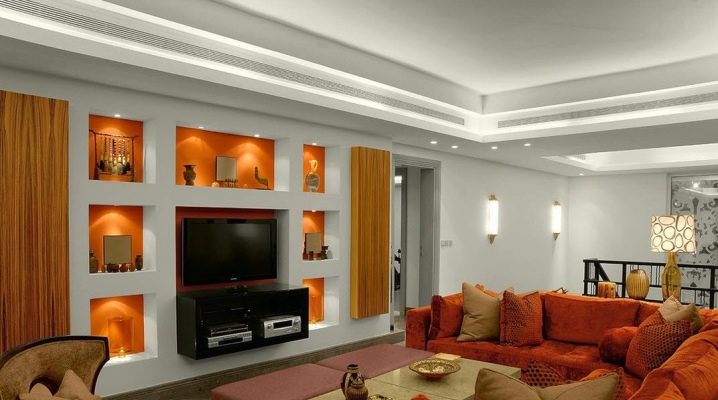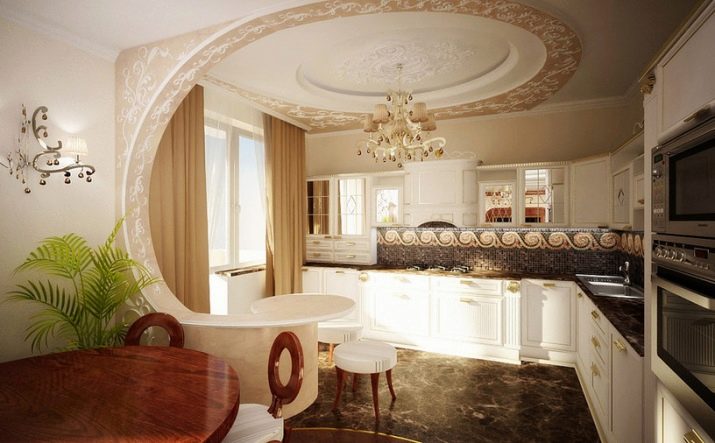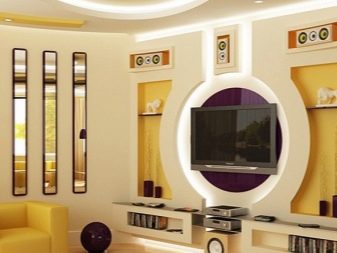Plasterboard decors in the interior

An apartment of a modern person is not only a functional room equipped with everything necessary for a comfortable life, but also a space that reflects the character and inner state of its owner. Designers try to develop a unique and beautiful interior for the customer using various decorative techniques. The creation of curly plasterboard structures is one of the ways to decorate a room.






Material features
Plasterboard is widely used in construction and finishing works all over the world. This is a type of building material, consisting of sheets of cardboard, between which there is a hard gypsum dough, supplemented with various fillers.
Depending on the additional properties, ordinary (GKL), moisture-resistant (GKLV) and fire-resistant (GKLO) drywall are distinguished.


Plasterboard figures, depending on their complexity and functional load, are mounted directly on the wall, ceiling or on a special profile frame. Thanks to the pliability of the material, you can create all kinds of volumetric patterns, waves and other decorative elements. Having made the necessary calculations, it is possible to install a simple rectangular structure with your own hands.
The undoubted advantage of this building material is its environmental friendliness., which makes it possible to use it in the children's room. Due to the presence of moisture resistant types, drywall is suitable for creating decor in the bathroom and in the kitchen. Sheathing the wall in the bedroom, you can achieve additional sound insulation of the room.



Types of decor
When developing a room design using plasterboard decorative elements, it is necessary to clearly understand what function they will perform. Depending on this, the installation method, type of material and additional fasteners will differ. You can conditionally highlight functional and purely decorative elements.
Functional decors, in addition to decorating the interior, can also serve as storage space, they can also be a delimiting structure or a way to hide communications.



Arches
Since the material can be given almost any curved shape, the design of the arch is limited only by the imagination of the customer. This element is used to decorate both doorways and individual sections of the wall, using part of the ceiling. Arches can be blind or with through openings for arranging vases, figurines and other decorative trifles.
Often, additional lighting is mounted in a plasterboard structure, which is used as a separate light source or illumination for decorative elements.



Niches
It is not always possible or necessary to install separate cabinets or racks in rooms. In this case, a technique such as installing a drywall niche is useful. This design has several advantages over traditional storage systems.
- The niche is built as an inseparable part of the wall, which allows it to be integrated into the interior as organically as possible.
- The parameters are set by the customer, there are no restrictions on sizes and shapes.
- With the final finishing, you can arrange it in the same way as the walls of the room, then the structure will not stand out. This is true for small spaces. Thanks to this technique, the space will not be visually cluttered, but there will be a place for placing the necessary things.
- Another option is to make the niche a separate bright decorative element. To do this, you can paint it in a contrasting color, install mirror panels on the back walls, mount a backlight or lay out a mosaic pattern.



Shelving or false walls
Often, for zoning space, they use this type of plasterboard decors, such as small wall structures. With their help, you can select functional areas without making the interior heavier.
In order not to deprive part of the room of the light source, false walls are often made through. In this case, a kind of rack is obtained, which is suitable for arranging all kinds of objects: books, vases, figurines, photographs.


Designers also use drywall as a material to create various volumetric decorative wall or ceiling figures. Natural motives are very popular. With the help of a rigid frame, drywall smoothly bends and takes the shape of, for example, a flower, a butterfly or a cloud.
On the wall, such a figure is usually highlighted with a contrasting color, and on the ceiling, in order to avoid visual pressure, it is painted in a neutral tone, but the backlight is mounted.


If there is no desire to build a complex figure, but it is necessary to select part of the wall, you can design a frame from drywall. Having painted it in a lighter tone compared to the wall, we get a convex structure. A darker color will create the effect of a depression, a dip.


Another type of decor is a fireplace portal. In modern apartments there is no way to lay out a real fireplace, but you can convey comfort and a special homely atmosphere using drywall. A gas heating element or ordinary candles are often installed in the finished portal.
With such a decor, it is necessary to remember about safety, therefore it is better to use a fire-resistant material and entrust the installation of the structure to professionals.


Finishing methods
Before the final finishing of decorative figures, there is no need to level the surface, which significantly saves both time and money. At the same time, it is still worth paying attention to the joints and corners so that cracks do not form on the surface during operation. Drywall is a versatile material, so there are many finishing methods.
- Surface painting is the simplest and most economical option. The composition is easily applied to the gypsum board, no additional surface preparation and special skills are required.
- Wallpaper is usually pasted over a large surface of a niche installed behind the head of a bed or sofa. For these purposes, it is better to choose textured or fabric wallpaper. This will create an interesting contrast to the main solid color wall.


- Decorative plaster will fit well on a drywall surface, but remember that due to its rough texture, it is not suitable for decorating children's rooms or narrow, angular rooms.
- You can decorate a decorative element with an artificial stone. This is a rather costly method, therefore, they usually only decorate the perimeter of the arch or the fireplace.


- Tiles or mosaics are also fine finishes. Having chosen this method, it is worth strengthening the structure with a reinforced mesh due to the significant weight of the finishing materials.
- Polyurethane stucco molding will help add sophistication and nobility to the interior. With its help, you can create a separate textured decorative element on a plasterboard structure, for example, in a niche.


Room decoration ideas
- Small vertical niches are usually installed in the hallway. They can be fitted with additional lighting or a full-length mirror, and narrow shelves can be used to store keys, gloves and other little things. Often, apartment owners refuse to install doors between the corridor and the main part of the room, in this case, an arch will help to visually delimit the space.


- If you purchase a waterproof material, you can use it to install decorative structures in the bathroom or kitchen.A small niche with shelves or a rack installed in the bathroom will help solve the problem of storing towels and cosmetics. And if there is enough space, you can mount the washing machine in a specially built rack decorated with ceramic tiles.


- Shelves and false walls will help you zone the space in a studio apartment. A blank wall located between the kitchen area and the living room will delimit the space. On one side of it, a table and chairs can be conveniently placed, the other can be used as a support for a TV. Plasterboard shelving is enough to simply separate the working or sleeping area.
Using this type of decor, apartment owners get additional storage space: beautiful little things can be placed in the upper part, and closed boxes can be installed at the bottom.


- When decorating a hall, a niche of gypsum plasterboard is often mounted for installing television and audio equipment. A three-dimensional figure in the form of a flower will look interesting on the wall opposite from the sofa or in a niche behind it, as well as on the ceiling. If the height of the ceilings allows, it is recommended to install a plasterboard cornice. All fasteners will be removed and the heavy drapery will be nicely framed.


- In the children's room, floor shelves or cabinets will be well placed. Strengthening the frame of the structure, you can get a place for storing toys, and putting a mattress or pillows on the surface - an additional place to rest. Illuminated volumetric figures installed on the wall will successfully replace traditional bedside lamps. They are shaped like clouds, stars, the moon, or a fairy-tale character.


- In the bedroom, a niche at the head of the bed looks good. Additional lighting creates a soft, cozy atmosphere, and the shelves eliminate the need to select bedside tables.
Plasterboard frames, painted a tone lighter than the main wall or decorated with wallpaper in the form of a panel, will add sophistication to the interior without disturbing the unity of space.


Plasterboard decors will help create a beautiful and comfortable interior in any apartment. Their use is wide enough, so choosing the right design for a particular room is not difficult.
For information on how to make a plasterboard niche with lighting in the kitchen, see the next video.













The comment was sent successfully.